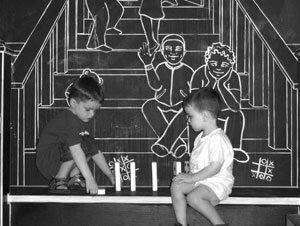CULTURE- BUZZBOX- My turn! Let the games begin
In the electronic age where hip kids are so tuned in to virtual reality, the Virginia Discovery Museum's summer exhibit "Games from Around the World" may be just another quaint review of historical artifacts. When, for example, was the last time you saw a group of neighborhood kids gathered on the front porch stacking up a line of dominoes or drawing a circle in the dirt for a round of marbles? Here is a place where kids of all ages (parents are welcome, too) can explore a different reality as they hang out in the Back Gallery and discover the joy of pure play.
Kids must get involved in this ultra-interactive exhibit featuring games from around the world. In the carnival area, daredevils can take a chance at the Mexican game Loteria, a game similar to bingo where players match images and words rather than numbers on a card. Others can try their luck tossing rings around the pop bottles or throwing a beanbag into a lion's mouth.
Contrary to popular belief, the world's most popular game is not baseball or football; it's soccer. This and other outdoor games– including shuffleboard and bowling– have an indoor version in the exhibit.
The museum's active honeybee hive is part of this exhibit, too, and is abuzz with a big game of concentration. Busy little human bees can search the cards for images of sunflowers, strawberries, watermelon, and other yummy nectar-filled plants. On the magnet wall, the Chinese puzzle game Tangrams gives those with an eye for shape the chance to arrange the black squares, rectangles, triangles, and parallelograms into images of a cat, bear, candle, or sailboat.
One potato, two potato, three potato, four... Parents can teach their kids the skipping rhymes they sang jumping rope. And everyone can stick their fists in a circle and tap out "eenie, meenie, miney, moe." Catch a tiger by the toe to see who will be "It." Out on the sidewalk, kids can get out the chalk and draw a hopscotch grid, not just in the American style, but also in a spiral as they do in Bolivia, or in circles as is done in Germany.
The impressive collection of at least a dozen board games from around the world can keep older players busy all day. Two tables are laid out with instructions and playing pieces for games such as Chinese checkers (which actually came to us from Germany), backgammon (one of the oldest games in the world originating in Mesopotamia), and Go (a game of strategy from Japan).
And sometimes you just have to play with what you have at hand. The counting game mancala from Africa, for example, uses stones, seeds, or tiny shells dropped in an array of cups or even shallow holes in the ground. Pachisi (the Royal Game of India, known as Parcheesi in this country) uses wooden sticks instead of dice. Fanorona, a strategy game from Madagascar, uses bottle caps to dominate the board.
However quaint this exhibit may seem on the surface, this is serious play that kids of all ages definitely get a kick out of. They may even learn something new, too. Who knew?

Publicity photo
#